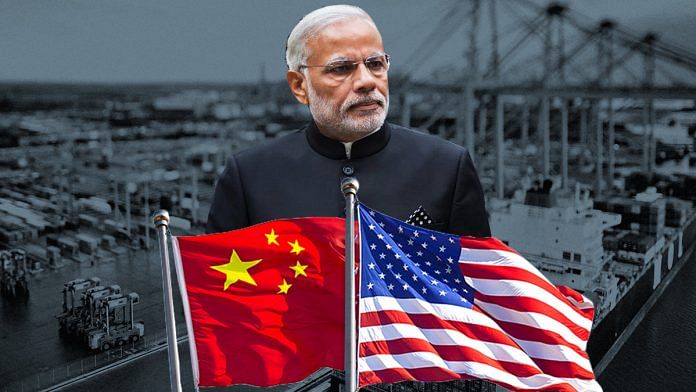
Despite repeated warnings from the US, the European Union’s recent Comprehensive Agreement on Investment with China raised eyebrows across the world. And even Donald Trump’s parting shot was to revive the trade pact with the Beijing administration. Australia also signed a 15-member Regional Comprehensive Economic Partnership with China in November. In a slowing economy, all three have revived some level of trade relationship with China. But as countries scramble to find new partners and new trade pacts in the wake of Covid, India is looking at a future where there is no China because of border tensions, and instead has lined up a few minilaterals whose outcomes are unknown.
It seems that China is able to impose itself as a critical business partner even at a time when countries have been grouping up against its increasing belligerence under the Xi Jinping administration. India has been a rare exception in maintaining a consistent stance against China in terms of trade, blocking Chinese investment in April last year and walking out of the RCEP in November 2019. This stance has been bolstered by the Ladakh standoff.
What it means is that while leading countries that are part of the large-scale and complex global value chains and supply networks have begun to find ways to do business with China, India will be the only country to be left out of all such trade and economic blocs or groupings.
Also read: A year after Covid, China’s economic growth accelerates as rest of world struggles
Warming up to China?
Just as the world was busy wrapping up the tumultuous year of 2020, Europe silently went ahead and signed the Comprehensive Agreement on Investment (CAI) with Beijing, throwing caution to the wind while making it clear to the world that for pragmatic Europeans, business comes before geopolitics.
The CAI seeks to replace 26 existing bilateral investment treaties between EU member states and China, and establish a uniform legal framework for EU-China investment ties.
This comes close to the incoming Joe Biden administration’ clear indication that it will make America re-enter the Trans Pacific Partnership (TPP), now known as the Comprehensive and Progressive Trans Pacific Partnership (CPTPP), which was originally backed by the Barack Obama administration before the Trump administration withdrew from it in 2017. But just before his exit from the White House, Trump signed a trade pact with China after being engaged in a trade war during much of his tenure.
While it certainly won’t be easy for the Biden administration to complete the CPTPP deal, once done, it will make the US party to a humongous trade pact, which is pegged to be the world’s largest free trade deal.
The CPTPP, which was signed between 11 countries creating a free trade area in 2018 after the US’ exit, may soon have Europe joining it. The UK, post Brexit, is also planning to be part of the grouping.
Last month, Australian High Commissioner to India Barry O’Farrell told ThePrint in an interview that Canberra has joined the RCEP despite its differences with China because it supports open markets and encourages expanded trade and investment. “We also recognise trade and investment will be key to rebuilding our economies post Covid, and ensuring future sustained economic development,” O’Farrell said.
Also read: US offer to help fight China at LAC aimed to ‘accelerate India’s rise as Major Defense Partner’
What India is focusing on
In April 2020, shortly before the ongoing tensions in Ladakh first cropped up, the Narendra Modi government took several steps to restrict foreign investments from China. New Delhi completely shut the door for Chinese investors or for any preferential trading arrangement with Beijing. Earlier this month, outgoing US Ambassador to India Kenneth Juster, in his farewell speech, sharply highlighted rising trade barriers in India, saying that during his tenure, he experienced most “frustration and friction” in the US-India bilateral trade. He also made it clear that in order to become a credible manufacturing hub and to become an alternative to China, New Delhi has to undertake some serious measures.
“As US and other companies find it increasingly difficult to operate in China or seek to diversify away from Chinese-led supply chains, India has a strategic opportunity to become an alternative destination for manufacturing in the Indo-Pacific … To fully seize the opportunity, the Indian government may well need to take further action,” he said.
India’s top three trading partners – the US, EU and China – slammed New Delhi during a trade policy review at the World Trade Organization (WTO) held from 6-8 January in Geneva.
The US, in its feedback to the WTO on India’s trade policy, said that if New Delhi continues to raise its tariff structure, it will “not facilitate India’s further integration into global supply chains.”
And so, India is now trying to become part of the post-Covid supply chain network by joining certain small groupings in the form of ‘minilaterals’ under the Indo-Pacific strategic initiative.
Minilaterals are quintessentially ad-hoc trading arrangements depending on the existing scenarios. They are voluntary setups and not legally binding, unlike large-scale trade pacts. Minilaterals are viewed more critically in trade parlance compared to multilateral trade agreements. Since there is no legal basis to minilaterals, countries are not bound by common trading norms or a certain prescribed set of rules, which can become a cause of friction if anything goes wrong.



